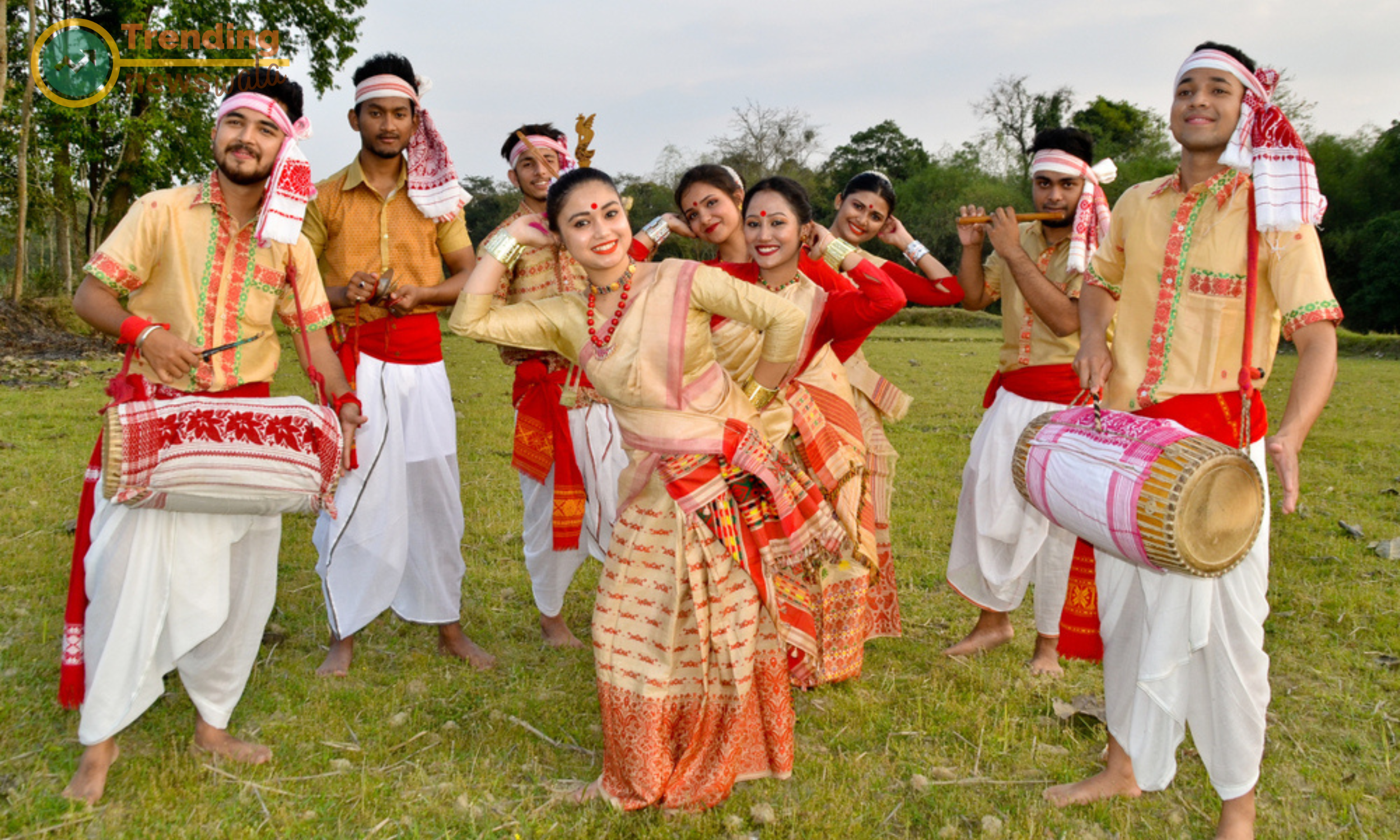Bihu is much more than just a festival; it is a celebration of Assamese culture, tradition, and community spirit. With its diverse rituals, vibrant festivities, and colorful customs, Bihu epitomizes the essence of Assamese identity and is a time for rejoicing, renewal, and togetherness.
Bihu, the most important festival of Assam, is a celebration of life, culture, and the spirit of harvest. With its roots deeply embedded in Assamese traditions, Bihu is a time of joyous festivities, colorful rituals, and vibrant cultural expressions. Here are the top ten traditions and customs that make Bihu a truly special occasion:
Rongali Bihu:
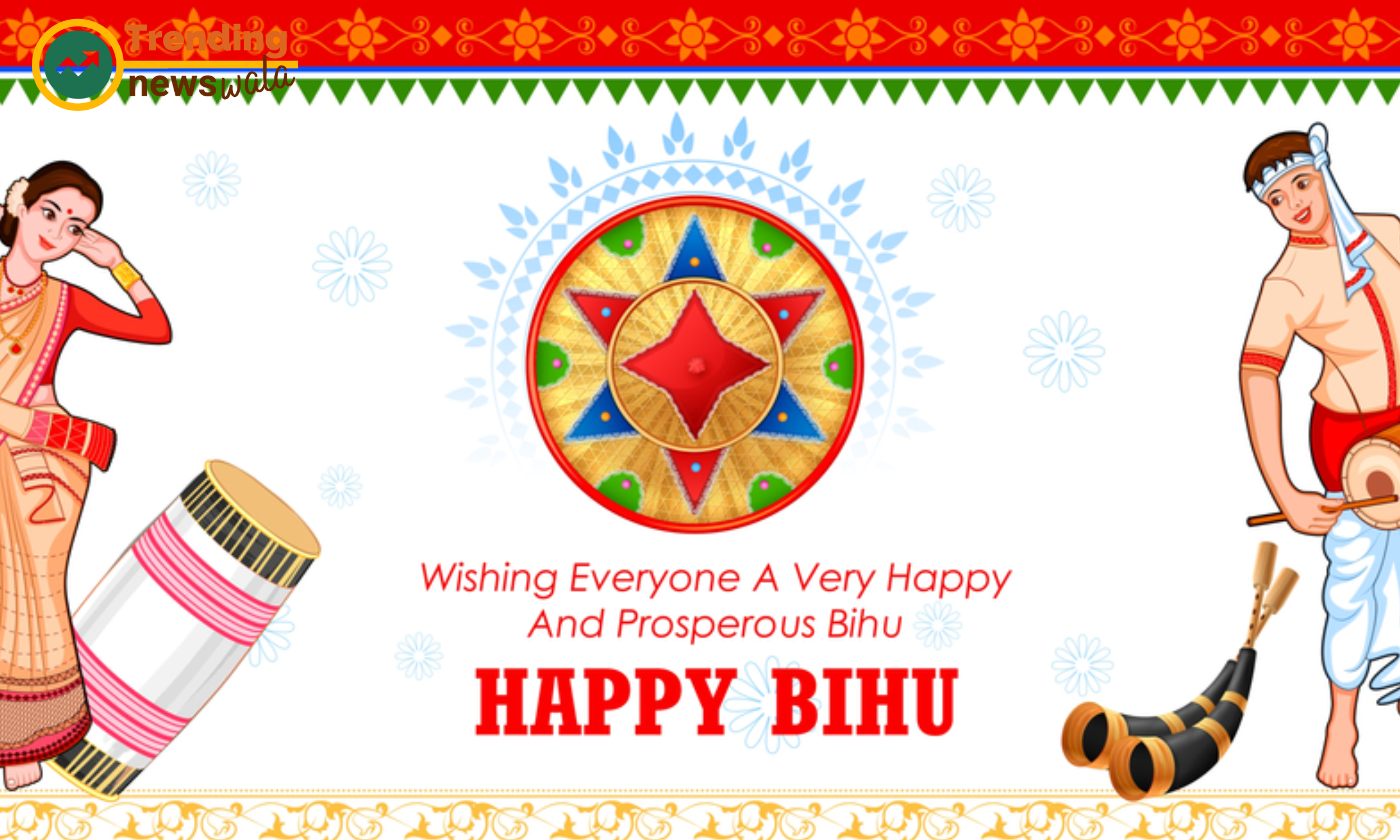
- Rongali Bihu, also known as Bohag Bihu, marks the Assamese New Year and the onset of the agricultural season. Celebrated in mid-April, it is a time of renewal, with communities coming together to welcome the new year with enthusiasm and joy.
- Rongali Bihu, also known as Bohag Bihu, stands as the epitome of joy, exuberance, and cultural vibrancy in the northeastern state of Assam, India. Celebrated with immense fervor and enthusiasm, Rongali Bihu marks the advent of the Assamese New Year and the arrival of spring. It is a festival deeply entrenched in the agrarian roots of Assamese society, signifying hope, abundance, and renewal. Let's delve into the splendor of Rongali Bihu and explore the top 10 facets that make this festival an integral part of Assamese cultural heritage.
- Cultural Extravaganza: Rongali Bihu unfolds as a grand cultural extravaganza, featuring a plethora of traditional rituals, performances, and festivities. From melodious Bihu songs echoing in every corner to mesmerizing Bihu dances like the 'Bihuwaan' and 'Jeng Bihu', the festival fills the air with infectious energy and merriment. Communities come together to showcase their artistic prowess through vibrant attire, intricate handcrafted ornaments, and graceful dance movements, making Rongali Bihu a visual spectacle to behold.
- Symbolism of Spring: As the harbinger of spring, Rongali Bihu heralds the end of the harsh winter months and welcomes the season of rejuvenation and abundance. The lush greenery, blooming flowers, and vibrant colors of spring serve as a backdrop to the festivities, symbolizing growth, prosperity, and new beginnings. The festival encapsulates the essence of nature's renewal, instilling a sense of optimism and vitality in the hearts of the celebrants.
- Agricultural Significance: Rooted in agrarian traditions, Rongali Bihu holds immense significance for farmers and agricultural communities across Assam. It marks the beginning of the agricultural season, signaling the time for sowing seeds and nurturing crops. Farmers invoke the blessings of deities for a bountiful harvest and engage in rituals to seek divine favor and protection for their crops. Rongali Bihu underscores the symbiotic relationship between humans and nature, emphasizing the importance of sustainable agriculture.
- Traditional Rituals: Rongali Bihu is steeped in age-old rituals and customs passed down through generations. One such ritual is 'Goru Bihu', where cows are bathed, adorned with garlands, and worshipped as symbols of fertility and prosperity. Another integral aspect is the 'Manuh Bihu', where families gather to seek blessings from elders, exchange traditional sweets and greetings, and partake in communal feasting. These rituals foster a sense of unity, reverence, and familial bonds within the community.
- Delicious Cuisine: No celebration of Rongali Bihu is complete without indulging in the delectable Assamese cuisine that tantalizes the taste buds. Traditional delicacies like 'pitha' (rice cakes), 'laru' (sweet balls), 'doi-chira' (curd with flattened rice), and 'maasor tenga' (fish curry) adorn the dining tables, offering a gastronomic delight to the revelers. The festival is a celebration of culinary richness, where families come together to savor the flavors of Assam's culinary heritage.
- Symbolic Bonfires: Central to Rongali Bihu celebrations are the 'Mejis', symbolic bonfires made of bamboo, thatch, and wood. These bonfires are lit on the eve of Bihu to ward off evil spirits and usher in prosperity and happiness. People gather around the 'Mejis' to offer prayers, sing traditional Bihu songs, and engage in cultural performances. The crackling flames of the 'Mejis' symbolize the triumph of light over darkness, igniting a spirit of hope and positivity among the participants.
- Community Bonding: Rongali Bihu serves as a catalyst for fostering communal harmony, solidarity, and goodwill among people from diverse backgrounds. It transcends barriers of caste, creed, and ethnicity, uniting individuals in a shared celebration of culture and tradition. Communities organize 'Bihu committees' and cultural programs, providing platforms for participation and collaboration. Rongali Bihu exemplifies the spirit of inclusivity and camaraderie, strengthening the social fabric of Assamese society.
- Innovative Festivities: While preserving age-old customs, Rongali Bihu also embraces innovation and creativity, adapting to the evolving times. Modern interpretations of Bihu songs and dances blend seamlessly with traditional performances, catering to the diverse tastes of the younger generation. Cultural competitions, fashion shows, and Bihu-themed events add a contemporary flair to the festivities, ensuring that Rongali Bihu remains relevant and engaging for people of all ages.
- Spirit of Generosity: Rongali Bihu embodies the spirit of generosity and philanthropy, as people extend a helping hand to the less fortunate during the festival. Charitable initiatives, such as food distribution drives, clothing donations, and community service projects, are organized to spread joy and alleviate hardships. The act of giving during Rongali Bihu reinforces the values of compassion, empathy, and social responsibility, enriching the lives of both the giver and the recipient.
- Legacy of Resilience: Above all, Rongali Bihu encapsulates the resilience and spirit of the Assamese people in the face of adversity. Despite the challenges posed by natural calamities, social upheavals, or global pandemics, the fervor and zeal of Rongali Bihu remain undiminished. It serves as a reminder of the indomitable human spirit and the enduring power of culture to unite, inspire, and uplift communities in times of need.
- Rongali Bihu stands as a testament to the cultural richness, heritage, and vitality of Assam, weaving together the threads of tradition, festivity, and spirituality into a vibrant tapestry of celebration. As Assamese people come together to revel in the joy of Rongali Bihu, they not only honor their cultural legacy but also reaffirm their bonds of kinship, resilience, and hope for a brighter future. In essence, Rongali Bihu transcends boundaries of time and space, embodying the eternal essence of life's cyclical journey – a celebration of harvest, renewal, and the eternal rhythm of nature.
Goru Bihu:
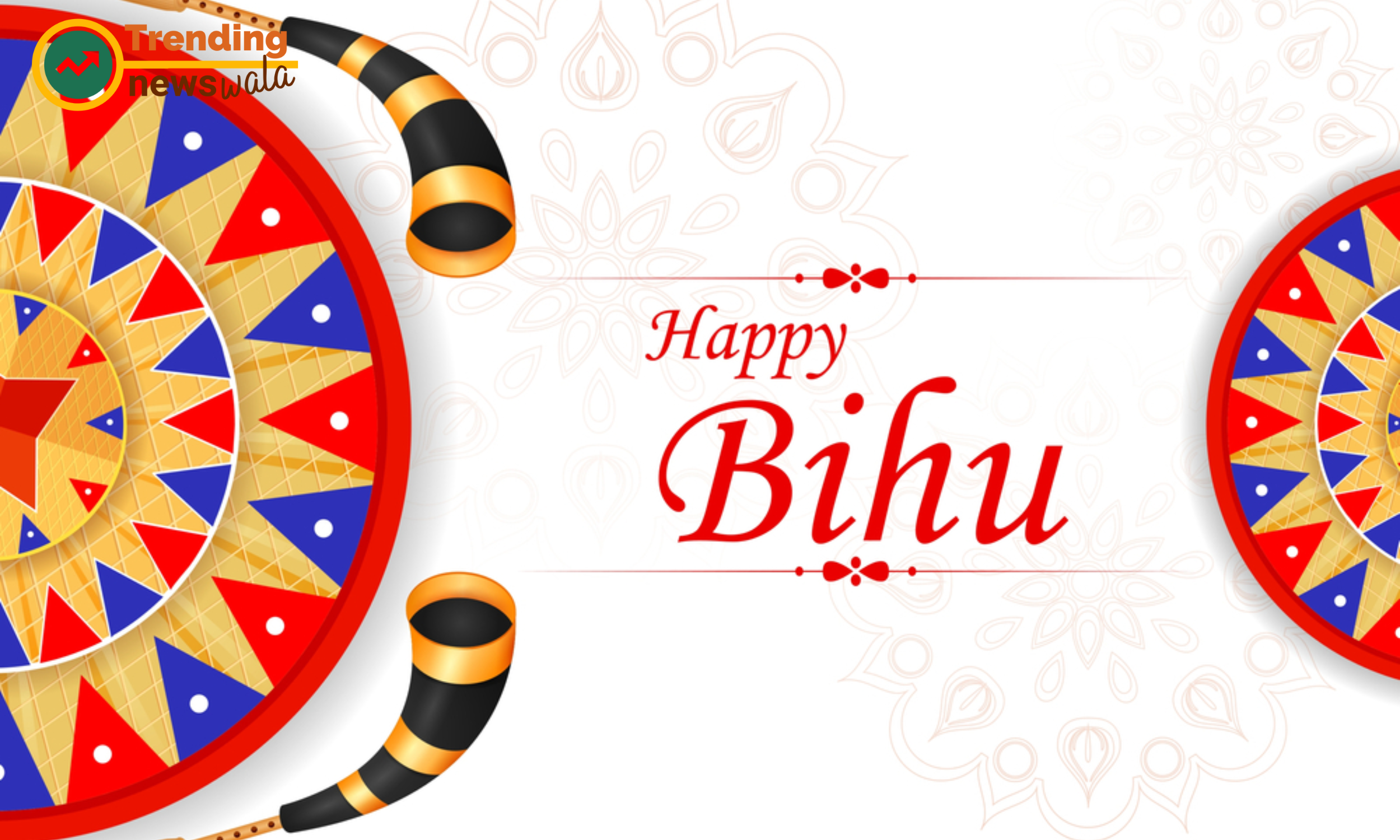
- Goru Bihu, observed on the first day of Rongali Bihu, honors and celebrates the role of cattle in agriculture. Cattle are bathed, adorned with garlands, and worshipped as a symbol of prosperity and abundance.
- Goru Bihu, also known as Cow Bihu, stands as a revered tradition within the colorful tapestry of Assamese culture, particularly during the festivities of Rongali Bihu. It is a celebration deeply rooted in the agrarian ethos of Assam, symbolizing the profound bond between humans and cattle. As the first day of Rongali Bihu, Goru Bihu holds a special place in the hearts of Assamese people, embodying gratitude, reverence, and communal harmony. Let's explore the significance and splendor of Goru Bihu as we delve into its top 10 aspects.
- Symbol of Fertility and Prosperity: Goru Bihu revolves around the worship and veneration of cows, which are regarded as symbols of fertility, prosperity, and agricultural abundance in Assamese culture. Cattle, particularly cows, hold immense importance in agrarian societies, serving as integral assets for plowing fields, producing milk, and sustaining livelihoods. By honoring cows during Goru Bihu, farmers express gratitude for their indispensable role in agricultural practices and seek blessings for a fruitful harvest season ahead.
- Ceremonial Bathing and Adornment: On the auspicious day of Goru Bihu, cows are bathed, groomed, and adorned with colorful garlands, vermilion, and sandalwood paste. The ceremonial bathing of cows is considered auspicious and is believed to purify them spiritually. Farmers meticulously decorate their cattle with ornate ornaments and floral wreaths as a gesture of reverence and respect. The sight of adorned cows during Goru Bihu adds to the festive ambiance, symbolizing the adornment of nature itself in preparation for the new agricultural cycle.
- Ritualistic Worship: Goru Bihu entails elaborate rituals and ceremonies conducted to honor cows and seek divine blessings for agricultural prosperity. Farmers perform 'puja' (worship) ceremonies, offering prayers, incense, and 'prasad' (sacred food) to the cows. Devotional hymns and mantras are recited to invoke the blessings of deities associated with agriculture, fertility, and cattle, such as Goddess Kamakhya and Lord Shiva. The rituals of Goru Bihu emphasize the sacredness of the bond between humans, animals, and the natural world.
- Fostering Community Bonds: Goru Bihu fosters a sense of communal harmony and solidarity as people come together to celebrate the festival with zeal and enthusiasm. It transcends social and economic divides, bringing together farmers, villagers, and communities from diverse backgrounds. The festival provides an opportunity for collective participation in rituals, cultural performances, and feasting, strengthening the bonds of kinship and camaraderie within the community.
- Prayers for Agricultural Prosperity: Central to Goru Bihu celebrations are prayers and rituals conducted to invoke the blessings of deities for a successful agricultural season. Farmers pray for timely rainfall, fertile soil, and protection from pests and natural calamities that could affect crop yield. The festival serves as a solemn occasion for farmers to reflect on the challenges and opportunities inherent in agricultural life and to seek divine intervention for a bountiful harvest.
- Acknowledgment of Cattle's Contribution: Goru Bihu serves as a poignant reminder of the invaluable contribution of cattle to agricultural livelihoods and rural economies. Cattle have been indispensable companions to farmers for centuries, providing labor for plowing fields, transporting goods, and producing dairy products. The festival acknowledges and honors the tireless efforts of these gentle beasts of burden, highlighting their role as silent partners in the sustenance and progress of agrarian societies.
- Cultural Festivities and Performances: Amidst the rituals and prayers, Goru Bihu also features cultural festivities and performances that add vibrancy and joy to the celebrations. Traditional dances like the 'Bihuwaan' and 'Goru Bihuwaan' are performed with gusto, accompanied by rhythmic beats of drums and cymbals. Folk songs and recitations narrating tales of agricultural life and rural folklore resonate in the air, captivating the audience with their lyrical charm. Goru Bihu is a time for revelry, laughter, and artistic expression, uniting people in shared cultural experiences.
- Emphasis on Animal Welfare: Goru Bihu underscores the importance of animal welfare and humane treatment of cattle, promoting compassion and care towards animals. Farmers ensure that their cattle are well-fed, sheltered, and cared for throughout the year, recognizing the symbiotic relationship between humans and animals. The festival serves as a platform to raise awareness about animal rights and ethical practices in animal husbandry, advocating for the well-being and dignity of all living beings.
- Culinary Delights and Community Feasting: No celebration of Goru Bihu is complete without indulging in sumptuous feasts and culinary delights prepared with love and care. Families gather to partake in communal meals featuring traditional Assamese dishes like 'pitha', 'laru', 'maasor tenga' (fish curry), and 'khar' (alkaline curry). The aroma of freshly cooked delicacies wafts through the air, tantalizing the taste buds and evoking a sense of nostalgia for flavors passed down through generations.
- Reflection and Gratitude: Above all, Goru Bihu is a time for introspection, reflection, and gratitude for the blessings bestowed by nature and the divine. Farmers express heartfelt appreciation for the abundance of the land, the fertility of the soil, and the life-sustaining resources provided by Mother Earth. Goru Bihu instills a sense of humility and reverence for the interconnectedness of all living beings, reminding humanity of its stewardship responsibility towards the environment and its inhabitants.
- Goru Bihu stands as a poignant tribute to the sacred bond between man and cattle, epitomizing the symbiotic relationship that sustains agricultural livelihoods and rural communities. As Assamese people gather to celebrate this auspicious festival, they honor the timeless traditions, cultural heritage, and spiritual values that define their identity. Goru Bihu serves as a beacon of hope, resilience, and harmony, embodying the eternal cycle of life, growth, and renewal in the agrarian landscape of Assam.
Manuh Bihu:
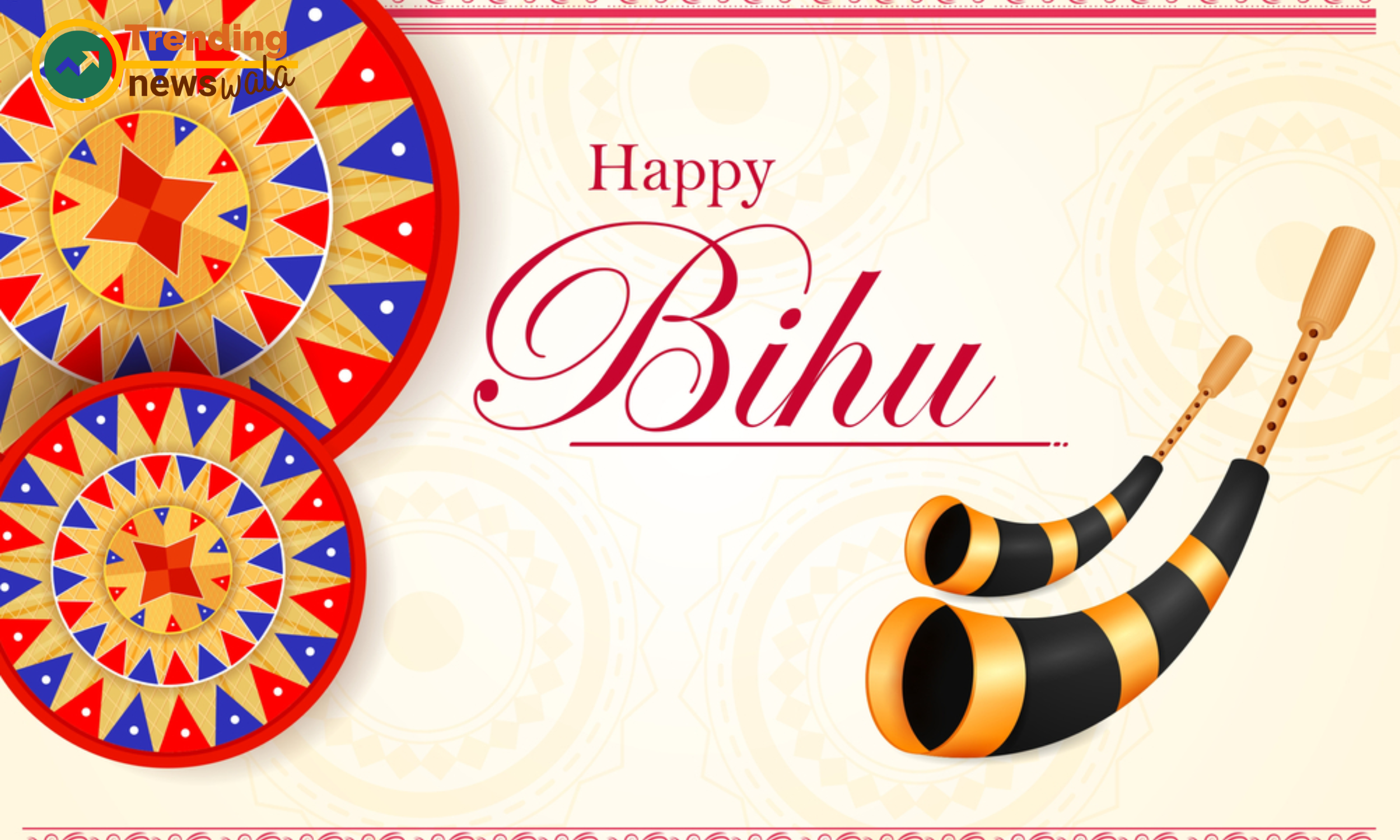
- Manuh Bihu, the second day of Rongali Bihu, is dedicated to humanity. It is a time for people to seek forgiveness, reconcile differences, and strengthen bonds of friendship and community.
- In the colorful tapestry of Bihu festivals that adorn the cultural landscape of Assam, Manuh Bihu emerges as a cherished occasion, steeped in tradition, familial bonds, and community spirit. Manuh Bihu, also known as Xaat Bihu or Manuh Bihuwaan, holds a special place in the hearts of Assamese people as it revolves around the essence of human connections, gratitude, and the celebration of life. Let's embark on a journey to unravel the significance of Manuh Bihu and explore the top 10 aspects that make it a cherished part of Assam's cultural heritage.
- Family Reunion: Manuh Bihu is synonymous with familial gatherings, where relatives from near and far come together to celebrate the spirit of togetherness and kinship. It serves as an occasion for family members to reconnect, reminisce about old memories, and create new ones. The warmth of familial bonds and the joy of shared experiences infuse Manuh Bihu with a sense of belonging and unity.
- Elders Blessings: A quintessential aspect of Manuh Bihu is seeking blessings from elders, known as 'Xaat Bihuwaan'. Younger members of the family pay homage to their elders by offering 'gamosa' (traditional Assamese cloth) and seeking their blessings for prosperity, happiness, and well-being. This ritual not only reinforces respect for elders but also fosters intergenerational harmony and the transmission of cultural values.
- Cultural Rituals: Manuh Bihu is replete with age-old customs and rituals that reflect the rich cultural heritage of Assam. Families engage in traditional rituals such as lighting 'diyas' (earthen lamps), offering prayers to household deities, and performing 'aarti' (rituals with incense and lamps). These rituals imbue the festival with spiritual significance and connect individuals to their cultural roots.
- Exchange of Gifts: Manuh Bihu is marked by the exchange of gifts and tokens of affection among family members and loved ones. It is customary to exchange 'bihuwanis' (gifts) such as clothes, sweets, fruits, and traditional items like 'gamosa' and 'jaapi' (Assamese conical hat). The act of gifting symbolizes love, appreciation, and goodwill, strengthening interpersonal relationships and fostering a sense of generosity.
- Traditional Attire: Dressing in traditional attire is an integral part of Manuh Bihu celebrations, as families adorn themselves in vibrant Assamese garments. Women don elegant 'mekhela chadors' or 'sarees', while men don 'dhoti-kurta' or 'gamocha' (traditional scarf). The colorful attire adds an aesthetic charm to the festivities and underscores the pride in Assamese cultural identity.
- Feasting and Festivities: No celebration of Manuh Bihu is complete without indulging in sumptuous feasts comprising traditional Assamese delicacies. Families prepare an array of mouth-watering dishes such as 'maal pua', 'luchi', 'pork curry', 'fish tenga', and 'payokh' (rice pudding) to delight the taste buds of their loved ones. The joyous atmosphere resonates with laughter, music, and the aroma of delectable food, creating cherished memories for years to come.
- Cultural Performances: Manuh Bihu witnesses a plethora of cultural performances and artistic expressions that captivate the audience and evoke a sense of pride in Assamese heritage. Families showcase their talents through music, dance, and theatrical performances, featuring traditional Bihu songs, 'Husori' (folk dance), and 'Borgeet' (devotional songs). These performances not only entertain but also serve as a platform for preserving and promoting Assamese culture.
- Community Bonding: Manuh Bihu fosters a sense of community bonding and solidarity, as neighbors, friends, and acquaintances come together to celebrate the festival. Community gatherings, cultural programs, and 'Bihu samitis' (committees) organize events to encourage participation and camaraderie. Manuh Bihu transcends individual households to create a sense of belonging and mutual support within the larger community.
- Reflecting on Gratitude: As families gather to celebrate Manuh Bihu, they take time to reflect on the blessings and achievements of the past year. It is a time to express gratitude for the abundance of nature, the support of loved ones, and the opportunities for growth and prosperity. Manuh Bihu instills a sense of humility and appreciation for life's blessings, fostering a positive outlook for the future.
- Preserving Cultural Heritage: Above all, Manuh Bihu serves as a custodian of Assamese cultural heritage, ensuring the continuity and preservation of age-old traditions for future generations. Through the transmission of customs, rituals, and values from one generation to another, Manuh Bihu reinforces the cultural identity and pride of the Assamese people. It stands as a testament to the resilience, diversity, and richness of Assam's cultural tapestry.
- Manuh Bihu epitomizes the essence of familial love, cultural heritage, and community spirit, weaving together the threads of tradition, festivity, and spirituality into a tapestry of celebration. As Assamese families come together to rejoice in the spirit of Manuh Bihu, they not only honor their cultural legacy but also strengthen the bonds of kinship, unity, and shared values. In essence, Manuh Bihu transcends mere rituals to embody the timeless values of love, gratitude, and togetherness that form the cornerstone of Assamese society.
Husori:
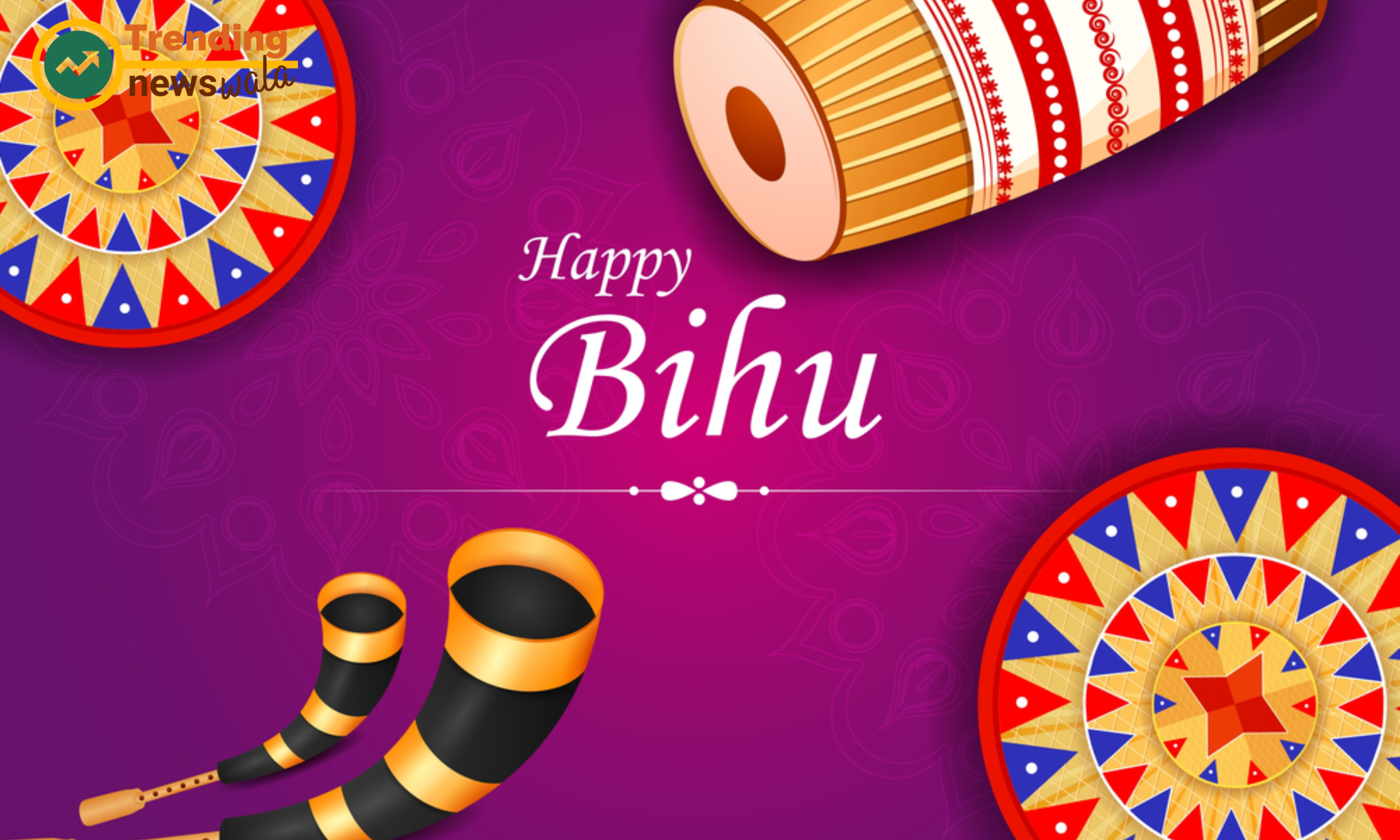
- Husori is a traditional form of Assamese folk music and dance performed during Bihu. Groups of musicians and dancers visit homes and villages, spreading joy and merriment with their rhythmic performances.
- In the colorful tapestry of Assamese culture, Husori emerges as a vibrant and cherished tradition, deeply intertwined with the spirit of Bihu festivities. Originating from the agrarian roots of Assam, Husori is a folk dance form characterized by its rhythmic beats, lively movements, and colorful attire. As an integral part of Bihu celebrations, Husori showcases the cultural vibrancy and communal spirit of the Assamese people. Let's embark on a journey to discover the essence of Husori and explore the top 10 facets that make it a cherished component of Bihu festivals.
- Cultural Heritage: Husori embodies the rich cultural heritage of Assam, reflecting the ethos and traditions of the region. Rooted in agricultural rituals and community gatherings, this folk dance form has been passed down through generations, preserving the essence of Assamese identity and values. The rhythmic beats of drums, cymbals, and bamboo instruments resonate with the spirit of celebration and unity, connecting people to their cultural roots.
- Traditional Attire: One of the defining features of Husori is the elaborate traditional attire worn by the performers. Men don vibrant dhotis, kurta, and Gamocha (traditional Assamese scarf), while women adorn themselves in colorful Mekhela Chadors or sarees. The attire is complemented by intricate jewelry, headgear, and accessories, adding to the visual splendor of the dance. The vibrant colors and patterns reflect the diversity and vibrancy of Assamese culture.
- Rhythmic Beats: At the heart of Husori are the rhythmic beats of traditional Assamese musical instruments such as the dhol, pepa (hornpipe), taal (cymbals), and gogona (bamboo jaw harp). The pulsating rhythms create an infectious energy that sets the stage alive with excitement and joy. The synchronized movements of the performers to the beats of the music evoke a sense of unity and camaraderie, transcending barriers of age and background.
- Community Participation: Husori is a communal dance form that encourages participation from people of all ages and backgrounds. It is performed during Bihu festivals, weddings, religious ceremonies, and other auspicious occasions, bringing communities together in celebration. The inclusive nature of Husori fosters a sense of belonging and camaraderie, as individuals join hands to create moments of joy and unity.
- Mythological Significance: Husori is often associated with mythology and folklore, with many of its songs and themes inspired by ancient legends and epics. The lyrics of Husori songs narrate tales of gods, goddesses, heroes, and love stories, adding a mystical dimension to the dance form. Through storytelling and music, Husori preserves the oral traditions of Assam, passing down cultural knowledge and wisdom from one generation to the next.
- Expression of Joy: Husori is a celebration of life, joy, and abundance, reflecting the spirit of Bihu festivals. The exuberant movements, rhythmic claps, and energetic footwork of the performers convey a sense of happiness and vitality. It is a time for people to set aside their worries and immerse themselves in the festive spirit, spreading laughter and cheer wherever Husori is performed.
- Spiritual Connection: Beyond its festive appeal, Husori also holds a spiritual significance for the Assamese people. The dance form is often performed as a form of worship during religious ceremonies and rituals, invoking blessings from deities for prosperity and well-being. Through Husori, devotees express their devotion and gratitude to the divine, seeking blessings for a harmonious and prosperous life.
- Regional Variations: While the essence of Husori remains consistent across Assam, there are regional variations in terms of style, repertoire, and performance. Different communities and tribes in Assam have their own unique interpretations of Husori, incorporating local customs, dialects, and musical instruments. These variations add to the diversity and richness of Assamese culture, showcasing the cultural mosaic of the region.
- Preservation Efforts: In recent years, there has been a renewed focus on preserving and promoting the tradition of Husori to ensure its continuity for future generations. Cultural organizations, educational institutions, and government initiatives have been instrumental in organizing workshops, festivals, and training programs to revive interest in Husori among the youth. These efforts aim to safeguard the cultural heritage of Assam and celebrate the legacy of Husori for years to come.
- Cultural Identity: Above all, Husori serves as a symbol of cultural identity and pride for the Assamese people. It embodies the resilience, creativity, and spirit of community that define the cultural ethos of Assam. Through Husori, the Assamese people celebrate their heritage, forge connections with their roots, and express their collective identity in a world of ever-changing dynamics.
- Husori stands as a testament to the enduring legacy of Assamese culture, uniting people through the universal language of music, dance, and storytelling. As an integral part of Bihu festivals, Husori encapsulates the essence of joy, togetherness, and cultural vibrancy that define the spirit of Assam. As communities come together to celebrate Husori, they honor their past, celebrate their present, and pave the way for a vibrant cultural legacy that will endure for generations to come.
Jeng Bihu:
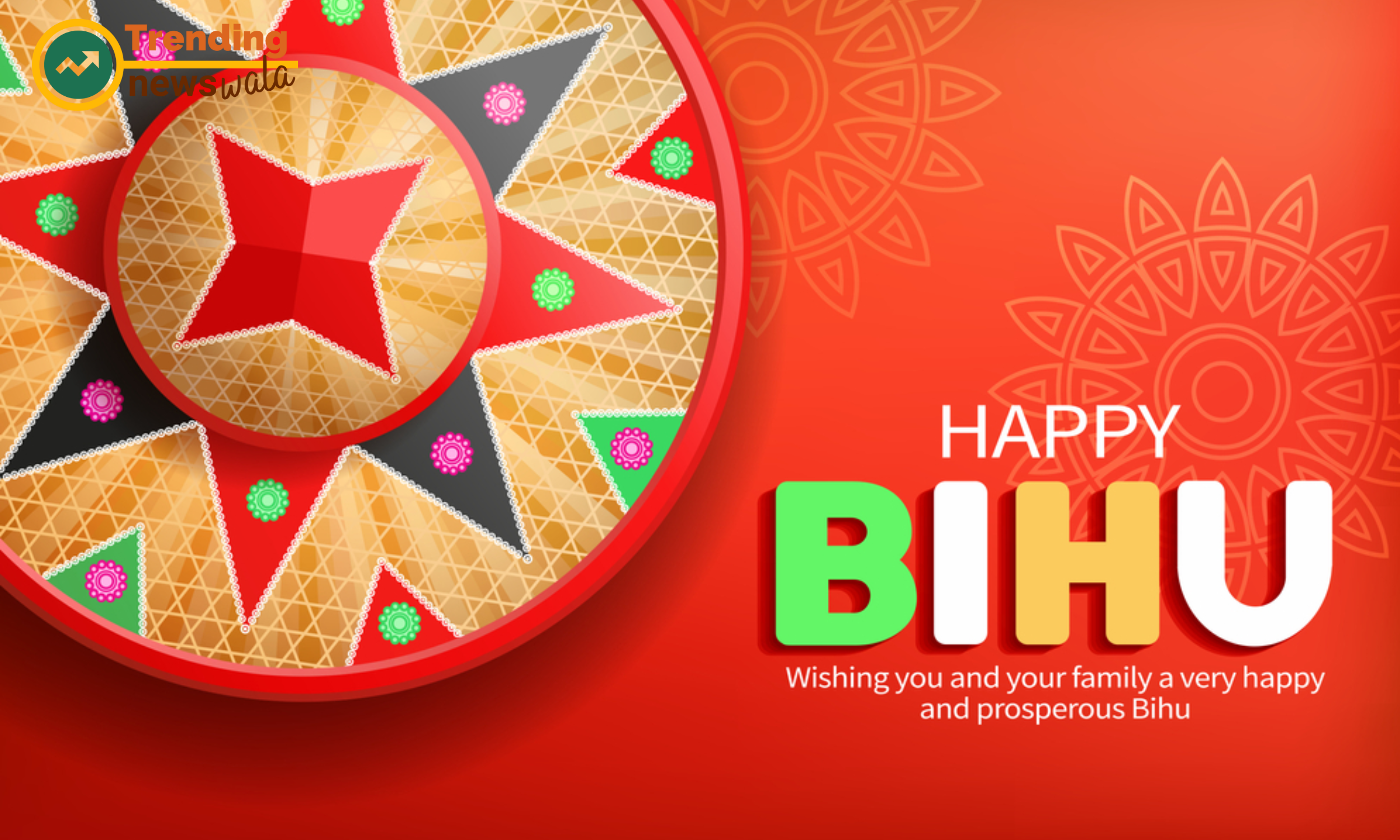
- Jeng Bihu, the concluding day of Rongali Bihu, is marked by traditional games, sports, and cultural competitions. Villages come alive with activities like buffalo fights, egg fights, and various indigenous sports.
- In the colorful tapestry of Assamese festivals, Jeng Bihu stands out as a dynamic and spirited celebration, pulsating with energy, rhythm, and cultural fervor. Rooted in the rich traditions of Assam, Jeng Bihu is a folk dance form that captivates audiences with its lively movements, rhythmic beats, and exuberant performances. As an integral part of Bihu festivals, Jeng Bihu embodies the essence of joy, camaraderie, and community spirit. Let's delve into the dynamic world of Jeng Bihu and explore the top 10 facets that make it a cherished tradition in Assamese culture.
- Dynamic Dance Form: Jeng Bihu is characterized by its dynamic and high-energy dance movements that captivate spectators with their vigor and grace. The dance involves rhythmic footwork, coordinated hand gestures, and intricate formations, creating a visual spectacle that mesmerizes audiences. Performers display agility, flexibility, and precision as they synchronize their movements to the pulsating beats of traditional Assamese music.
- Traditional Attire: Central to the allure of Jeng Bihu is the traditional attire worn by the performers, which adds to the visual splendor of the dance. Men don colorful dhotis, kurta, and Gamocha (traditional Assamese scarf), while women don elegant Mekhela Chadors or sarees adorned with intricate designs and motifs. The vibrant colors, rich fabrics, and embellishments reflect the cultural heritage and craftsmanship of Assam, enhancing the aesthetic appeal of Jeng Bihu.
- Rhythmic Beats: At the heart of Jeng Bihu are the rhythmic beats of traditional Assamese musical instruments such as the dhol, pepa (hornpipe), taal (cymbals), and toka (clapper). The pulsating rhythms create an infectious energy that infuses the dance with vitality and excitement. The syncopated beats and cadences drive the tempo of the dance, eliciting enthusiastic participation from performers and onlookers alike.
- Narrative Element: Jeng Bihu often incorporates a narrative element, with dancers portraying characters from Assamese folklore, mythology, and everyday life. The dance sequences depict themes of love, nature, harvest, and social customs, offering a glimpse into the cultural heritage and traditions of Assam. Through storytelling and expressive gestures, Jeng Bihu transports audiences to a world of imagination and wonder, enriching their cultural experience.
- Community Participation: Jeng Bihu is a community-driven dance form that encourages participation from people of all ages and backgrounds. It is performed during Bihu festivals, weddings, religious ceremonies, and other auspicious occasions, bringing communities together in celebration. The inclusive nature of Jeng Bihu fosters a sense of camaraderie and unity, as individuals join hands to create moments of joy and collective expression.
- Youth Engagement: Jeng Bihu plays a significant role in engaging and empowering the youth of Assam, providing them with a platform to showcase their talents and creativity. Young performers enthusiastically participate in Jeng Bihu performances, infusing the dance with their energy, enthusiasm, and innovative ideas. Through their involvement in cultural activities like Jeng Bihu, the youth connect with their cultural roots and take pride in their heritage.
- Cultural Preservation: Efforts to preserve and promote the tradition of Jeng Bihu are underway to ensure its continuity for future generations. Cultural organizations, educational institutions, and government initiatives organize workshops, festivals, and training programs to revive interest in Jeng Bihu among the youth. These initiatives aim to safeguard the cultural heritage of Assam and celebrate the legacy of Jeng Bihu as an integral part of Bihu festivals.
- Interplay of Tradition and Modernity: While rooted in tradition, Jeng Bihu also embraces elements of modernity, adapting to contemporary tastes and sensibilities. Innovative choreography, fusion music, and creative interpretations add a contemporary flair to Jeng Bihu performances, appealing to audiences of all generations. This interplay of tradition and modernity ensures the relevance and dynamism of Jeng Bihu in the ever-evolving cultural landscape of Assam.
- Symbol of Identity: Jeng Bihu serves as a symbol of cultural identity and pride for the people of Assam, reflecting their resilience, creativity, and spirit of community. Through Jeng Bihu, the Assamese people celebrate their cultural heritage, express their collective identity, and forge connections with their roots. The dance form embodies the essence of Assamese culture and values, serving as a source of inspiration and unity for generations to come.
- Celebration of Life: Above all, Jeng Bihu is a celebration of life, joy, and vitality, echoing the spirit of Bihu festivals. The dynamic movements, rhythmic beats, and vibrant performances embody the zest for life that defines the Assamese people. As performers and spectators come together to revel in the energy of Jeng Bihu, they create memories, forge bonds, and celebrate the beauty of cultural diversity and expression.
- Jeng Bihu stands as a vibrant and cherished tradition in Assamese culture, embodying the essence of joy, camaraderie, and cultural vibrancy. As an integral part of Bihu festivals, Jeng Bihu captivates audiences with its dynamic dance movements, rhythmic beats, and colorful performances. Through its storytelling, community participation, and youth engagement, Jeng Bihu fosters a sense of pride, unity, and celebration of life among the people of Assam. In essence, Jeng Bihu transcends mere entertainment to become a symbol of cultural identity and a testament to the enduring spirit of Assamese culture.
Bhogali Bihu:
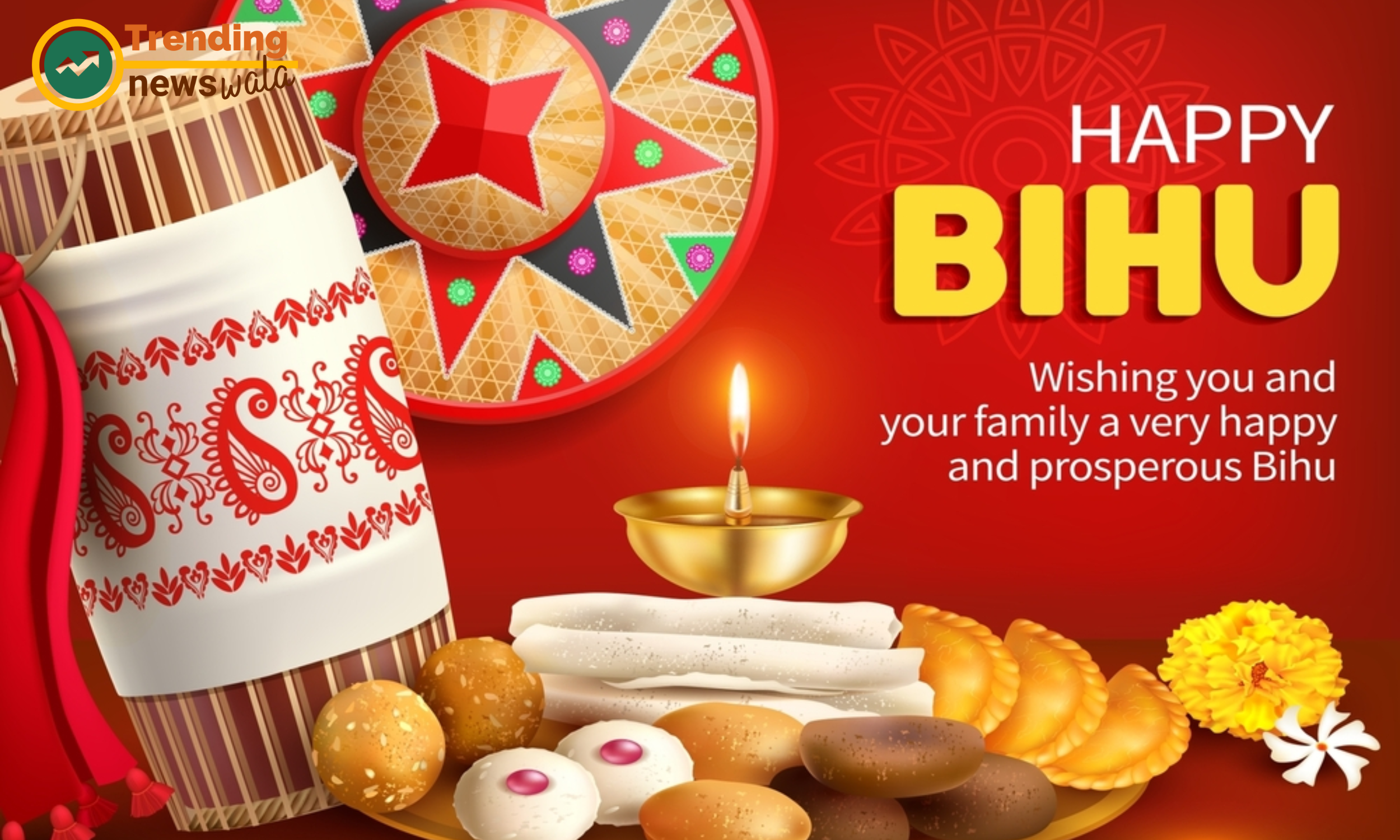
- Bhogali Bihu, also known as Magh Bihu, celebrates the harvest and marks the end of the harvesting season. It is characterized by feasting, bonfires, and traditional games such as buffalo fights and kite flying.
- In the vibrant tapestry of Assamese festivals, Bhogali Bihu stands out as a celebration of abundance, harvest, and community spirit. Also known as Magh Bihu or the festival of feasting, Bhogali Bihu is observed with great enthusiasm and fervor across Assam. It marks the culmination of the harvest season and provides an opportunity for communities to come together, indulge in lavish feasts, and revel in the spirit of togetherness. Let's delve into the cultural richness of Bhogali Bihu and explore the top 10 facets that make it a cherished tradition in Assamese culture.
- Harvest Festival: Bhogali Bihu is primarily celebrated as a harvest festival, symbolizing the culmination of months of hard work in the fields. It is observed during the Assamese month of Magh, which falls in mid-January, coinciding with the Hindu festival of Makar Sankranti. The festival is a time for farmers to reap the fruits of their labor, gather their harvest, and express gratitude to the deities for a bountiful yield.
- Feast of Plenty: At the heart of Bhogali Bihu is the tradition of lavish feasting, where families and communities come together to indulge in an array of delectable dishes. Traditional Assamese delicacies such as 'pitha' (rice cakes), 'laru' (sweet balls), 'sunga pitha' (rice cakes cooked in bamboo tubes), 'til pitha' (sesame seed cakes), 'bhaji' (vegetable fritters), and 'masor tenga' (sour fish curry) adorn the dining tables, tantalizing the taste buds of all present.
- Community Bonfires: A distinctive feature of Bhogali Bihu celebrations is the lighting of 'mejis', makeshift structures made of bamboo, thatch, and wood. These bonfires are lit on the eve of Bhogali Bihu to ward off evil spirits and usher in prosperity and happiness. People gather around the 'mejis' to offer prayers, sing traditional Bihu songs, and engage in cultural performances. The crackling flames of the 'mejis' symbolize the triumph of light over darkness and create a warm and inviting atmosphere for revelers.
- Traditional Games and Sports: Bhogali Bihu is also a time for engaging in traditional games and sports that add to the festive fervor. Communities organize various outdoor activities such as buffalo fights, bull fights, egg fights, and cockfights, where participants showcase their skills and compete for glory. These age-old games not only provide entertainment but also reinforce the cultural heritage and traditions of Assam.
- Cultural Performances: Bhogali Bihu witnesses a plethora of cultural performances and artistic expressions that captivate audiences and evoke a sense of pride in Assamese heritage. Communities organize Bihu cultural programs featuring traditional Bihu songs, dances, and theatrical performances. Folk artists and musicians entertain the crowds with their soulful renditions, celebrating the cultural richness and diversity of Assam.
- Prayers and Rituals: Amidst the festivities, Bhogali Bihu also includes prayers and rituals dedicated to the deities for blessings and prosperity. Families visit temples, offer prayers, and seek divine favor for a fruitful year ahead. The ritualistic worship of 'goddess Lakshmi', the deity of wealth and prosperity, is a common practice during Bhogali Bihu, symbolizing the aspiration for abundance and abundance in life.
- Community Bonding: Bhogali Bihu fosters a sense of community bonding and solidarity, as neighbors, friends, and acquaintances come together to celebrate the festival. Community gatherings, cultural programs, and 'Bihu samitis' (committees) organize events to encourage participation and camaraderie. Bhogali Bihu transcends individual households to create a sense of belonging and mutual support within the larger community.
- Cultural Diversity: While Bhogali Bihu is primarily associated with Assamese culture, it also reflects the cultural diversity and pluralism of Assam. The festival brings together people from different communities, tribes, and ethnicities, who contribute their unique customs, traditions, and culinary delights to the celebrations. This cultural exchange enriches the Bhogali Bihu experience and fosters cross-cultural understanding and harmony.
- Festival of Generosity: Bhogali Bihu is a festival of generosity and sharing, where people extend a helping hand to the less fortunate in society. Charitable initiatives such as food distribution drives, clothing donations, and community service projects are organized to spread joy and alleviate hardships. The act of giving during Bhogali Bihu reinforces the values of compassion, empathy, and social responsibility, enriching the lives of both the giver and the recipient.
- Legacy of Tradition: Above all, Bhogali Bihu embodies the legacy of tradition and heritage that defines Assamese culture. Passed down through generations, the festival serves as a reminder of the agrarian roots, cultural values, and resilience of the Assamese people. As communities come together to celebrate Bhogali Bihu, they honor their past, celebrate their present, and pave the way for a vibrant cultural legacy that will endure for generations to come.
- Bhogali Bihu is more than just a festival; it is a celebration of abundance, togetherness, and cultural heritage. As Assamese people gather to revel in the festivities of Bhogali Bihu, they not only honor their agrarian roots but also strengthen their bonds of kinship, unity, and shared values. In essence, Bhogali Bihu transcends mere feasting and merrymaking to become a symbol of the enduring spirit and resilience of Assamese culture.
Meji:
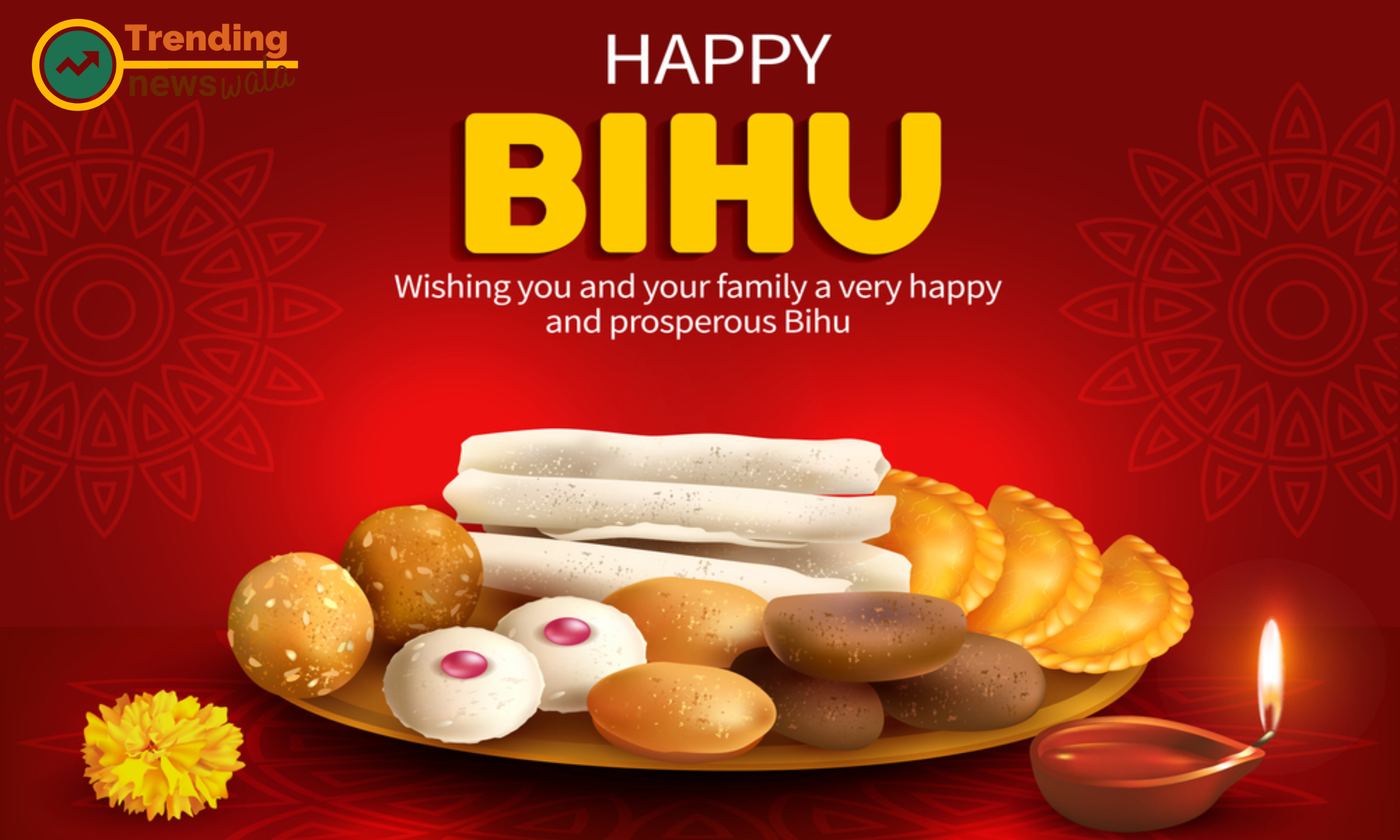
- Meji construction is a central ritual of Bhogali Bihu. Bamboo structures, known as Mejis, are erected and adorned with thatch, leaves, and traditional decorations. These structures are then set ablaze as an offering to the gods.
- In the vibrant tapestry of Assamese culture, the Meji stands as an emblematic structure that ignites the spirit of Bihu festivities with its fiery symbolism and communal significance. Erected during the festival of Magh Bihu, also known as Bhogali Bihu, the Meji serves as a beacon of prosperity, protection, and communal unity. Let's delve into the cultural richness of Meji and explore the top 10 facets that make it a cherished tradition in Assamese culture.
- Symbol of Abundance: The Meji holds profound symbolic significance as a representation of abundance and prosperity. Constructed using bamboo, thatch, and wood, the towering structure embodies the fertility of the land and the bounty of the harvest season. Its towering presence amidst the landscape serves as a visual reminder of nature's generosity and the blessings of a fruitful year.
- Ritualistic Construction: The construction of the Meji is a ritualistic affair that involves meticulous planning and communal participation. Families and communities come together to gather materials, erect the structure, and adorn it with decorative elements such as colorful cloth, earthen lamps, and rice husks. The process of building the Meji fosters a sense of camaraderie, cooperation, and shared responsibility among the participants.
- Warding off Evil Spirits: One of the primary functions of the Meji is to ward off evil spirits and negative energies that may threaten the well-being of the community. It is believed that the flames of the Meji purify the surroundings and drive away malevolent forces, ensuring protection and prosperity for the inhabitants. Lighting the Meji is seen as a ritualistic act of cleansing and renewal, ushering in positivity and auspiciousness.
- Cultural Rituals and Offerings: The lighting of the Meji is accompanied by elaborate rituals and offerings to appease the deities and seek their blessings. Families offer traditional sweets, rice cakes, fruits, and other delicacies to the gods, expressing gratitude for the abundance of the harvest season. Prayers are recited, hymns are sung, and incense is offered to invoke divine favor and ensure a prosperous year ahead.
- Community Gathering Point: The Meji serves as a focal point for community gatherings, cultural performances, and festivities during Bhogali Bihu. People gather around the Meji to engage in traditional Bihu dances, songs, and games, fostering a sense of togetherness and camaraderie. It becomes a hub of social interaction, where neighbors, friends, and relatives come together to celebrate the spirit of unity and shared heritage.
- Culmination of Harvest Celebrations: The lighting of the Meji marks the culmination of the harvest celebrations and the onset of the Magh Bihu festival. It signifies the transition from the agricultural season to the period of feasting, merrymaking, and communal revelry. The flames of the Meji illuminate the night sky, casting a warm glow over the landscape and enveloping the surroundings in an aura of festivity and joy.
- Traditional Bonfire Rituals: The lighting of the Meji is accompanied by traditional bonfire rituals, where people gather around the structure to offer prayers, sing Bihu songs, and perform cultural dances. The crackling flames of the Meji create a mesmerizing spectacle, illuminating the darkness and infusing the atmosphere with warmth and energy. It becomes a sacred space where people come together to connect with their cultural roots and celebrate the essence of Bihu festivals.
- Renewal and Regeneration: The Meji symbolizes the cycle of renewal and regeneration inherent in the agricultural cycle. As the flames of the Meji consume the structure, it represents the cycle of destruction and creation, death and rebirth. The ashes left behind are considered auspicious and are scattered in the fields as fertilizer, symbolizing the renewal of life and the promise of a fruitful harvest in the coming season.
- Cultural Continuity and Heritage: The tradition of building and lighting the Meji is deeply ingrained in Assamese culture, representing the continuity of age-old customs and traditions. Passed down through generations, the ritual of Meji embodies the cultural heritage and identity of the Assamese people. It serves as a link between the past, present, and future, preserving the legacy of Bihu festivals for posterity.
- Unity in Diversity: Above all, the Meji epitomizes the spirit of unity in diversity that characterizes Assamese culture. Regardless of caste, creed, or ethnicity, people come together to participate in the ritual of Meji, transcending differences and forging bonds of solidarity. It becomes a symbol of communal harmony, mutual respect, and collective celebration, reflecting the inclusive ethos of Assamese society.
- The Meji stands as a powerful symbol of cultural identity, communal unity, and spiritual significance in Assamese culture. As communities come together to build and light the Meji, they reaffirm their connection to the land, their heritage, and each other. In essence, the Meji represents the enduring spirit of Bihu festivals, encapsulating the essence of abundance, protection, and togetherness that define Assamese cultural ethos.
Community Feasts:
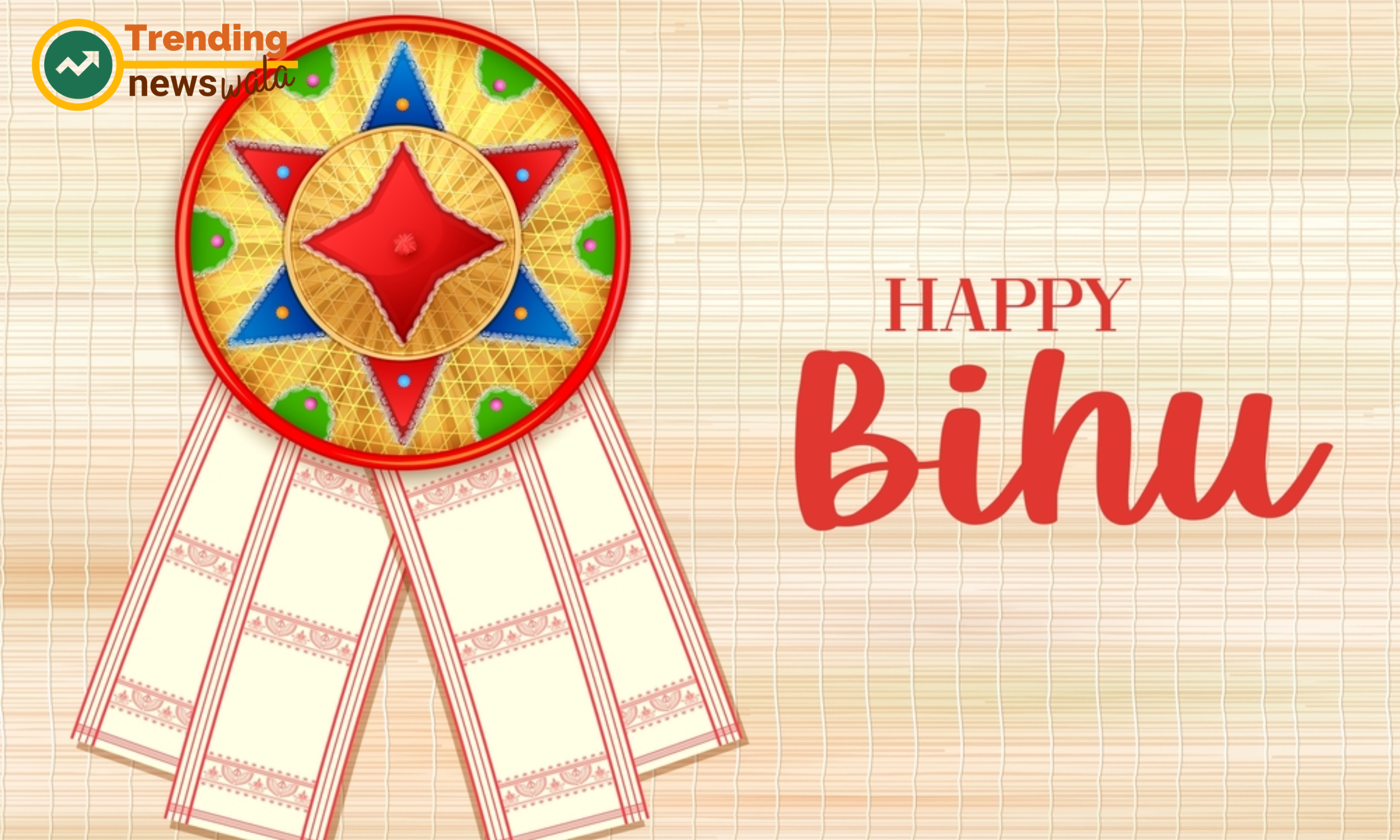
- Bihu is incomplete without the sumptuous feasts shared with family, friends, and neighbors. Traditional Assamese delicacies like pitha (rice cakes), laru (sweet balls), and various meat and fish dishes are prepared and savored with gusto.
- In the vibrant tapestry of Assamese culture, Bihu festivals are synonymous with joyous celebrations, vibrant traditions, and sumptuous feasts. Central to the spirit of Bihu festivities are the community feasts, where families, neighbors, and friends come together to indulge in a delectable array of traditional Assamese dishes. These feasts not only satiate the appetite but also foster bonds of kinship, camaraderie, and cultural solidarity. Let's delve into the heartwarming tradition of Bihu community feasts and explore the top 10 aspects that make them a cherished part of Assamese culture.
- Abundance of Culinary Delights: Bihu community feasts are a gastronomic delight, featuring an abundance of traditional Assamese dishes that tantalize the taste buds and showcase the culinary diversity of the region. From savory delights such as 'pitha', 'lassi', 'xandoh', and 'bamboo shoot curry' to sweet treats like 'til pitha', 'narikol laru', and 'komolabhog', the feasts offer a wide variety of flavors and textures to suit every palate.
- Traditional Cooking Techniques: A distinctive feature of Bihu community feasts is the use of traditional cooking techniques that have been passed down through generations. Families prepare dishes using age-old methods such as steaming, frying, roasting, and boiling, which enhance the flavors and nutritional value of the food. The use of locally sourced ingredients and indigenous spices adds a unique character to the dishes, reflecting the rich culinary heritage of Assam.
- Cultural Significance: Bihu community feasts hold profound cultural significance as they embody the spirit of sharing, generosity, and hospitality that are integral to Assamese culture. The act of hosting a feast and inviting guests is considered a gesture of goodwill and mutual respect, fostering bonds of friendship and solidarity within the community. It is a time for people to come together, celebrate their shared heritage, and strengthen the social fabric of society.
- Inclusive Nature: Bihu community feasts are inclusive gatherings that welcome people from all walks of life, irrespective of caste, creed, or ethnicity. It is not uncommon for neighbors, acquaintances, and even strangers to be invited to partake in the festivities, reflecting the spirit of openness and inclusivity that defines Assamese hospitality. The feasts provide an opportunity for people to forge new friendships, bridge cultural divides, and celebrate diversity.
- Family Reunions: Bihu community feasts serve as occasions for family reunions, where relatives from near and far come together to reconnect, reminisce, and strengthen familial bonds. It is a time for grandparents to pass on age-old recipes and culinary traditions to the younger generation, ensuring the preservation of cultural heritage for years to come. The joy of sharing a meal with loved ones creates cherished memories that endure beyond the festivities.
- Generosity and Sharing: A hallmark of Bihu community feasts is the spirit of generosity and sharing that pervades the gatherings. Hosts go to great lengths to ensure that guests are well-fed and looked after, offering an abundance of food and hospitality. It is not uncommon for guests to leave the feast with packets of leftovers or gifts as a token of appreciation for their presence. This culture of generosity fosters a sense of reciprocity and mutual support within the community.
- Festive Atmosphere: Bihu community feasts are characterized by a festive atmosphere, filled with laughter, music, and merrymaking. Guests are greeted with warmth and hospitality as they arrive, and the air is filled with the aroma of cooking food and the sounds of lively conversation. Traditional Bihu songs and dances add to the ambiance, creating a joyous and celebratory mood that pervades the festivities.
- Culinary Competitions: In some communities, Bihu community feasts feature culinary competitions where participants showcase their cooking skills and creativity. Dishes are judged based on taste, presentation, and authenticity, with prizes awarded to the winners. These competitions not only add an element of excitement to the feasts but also provide a platform for aspiring chefs to showcase their talents and learn from each other.
- Community Bonding: Bihu community feasts foster a sense of community bonding and solidarity, as neighbors, friends, and acquaintances come together to celebrate the festival. The feasts provide an opportunity for people to put aside their differences and come together in a spirit of harmony and cooperation. It is a time for reconciliation, forgiveness, and building bridges across divides, strengthening the social fabric of the community.
- Cultural Continuity: Above all, Bihu community feasts play a crucial role in preserving and promoting Assamese culture and culinary traditions. Through the sharing of food, stories, and customs, the feasts reinforce the cultural identity and pride of the Assamese people. They serve as a reminder of the rich cultural heritage that has been passed down through generations and the importance of preserving it for future generations to cherish and celebrate.
- Bihu community feasts are more than just culinary gatherings; they are vibrant celebrations of culture, community, and camaraderie. As guests come together to share a meal, they forge bonds of friendship, strengthen familial ties, and celebrate the richness and diversity of Assamese heritage. In essence, Bihu community feasts embody the spirit of generosity, sharing, and togetherness that lie at the heart of Assamese culture, ensuring that the traditions and values of the region endure for generations to come.
Traditional Attire:
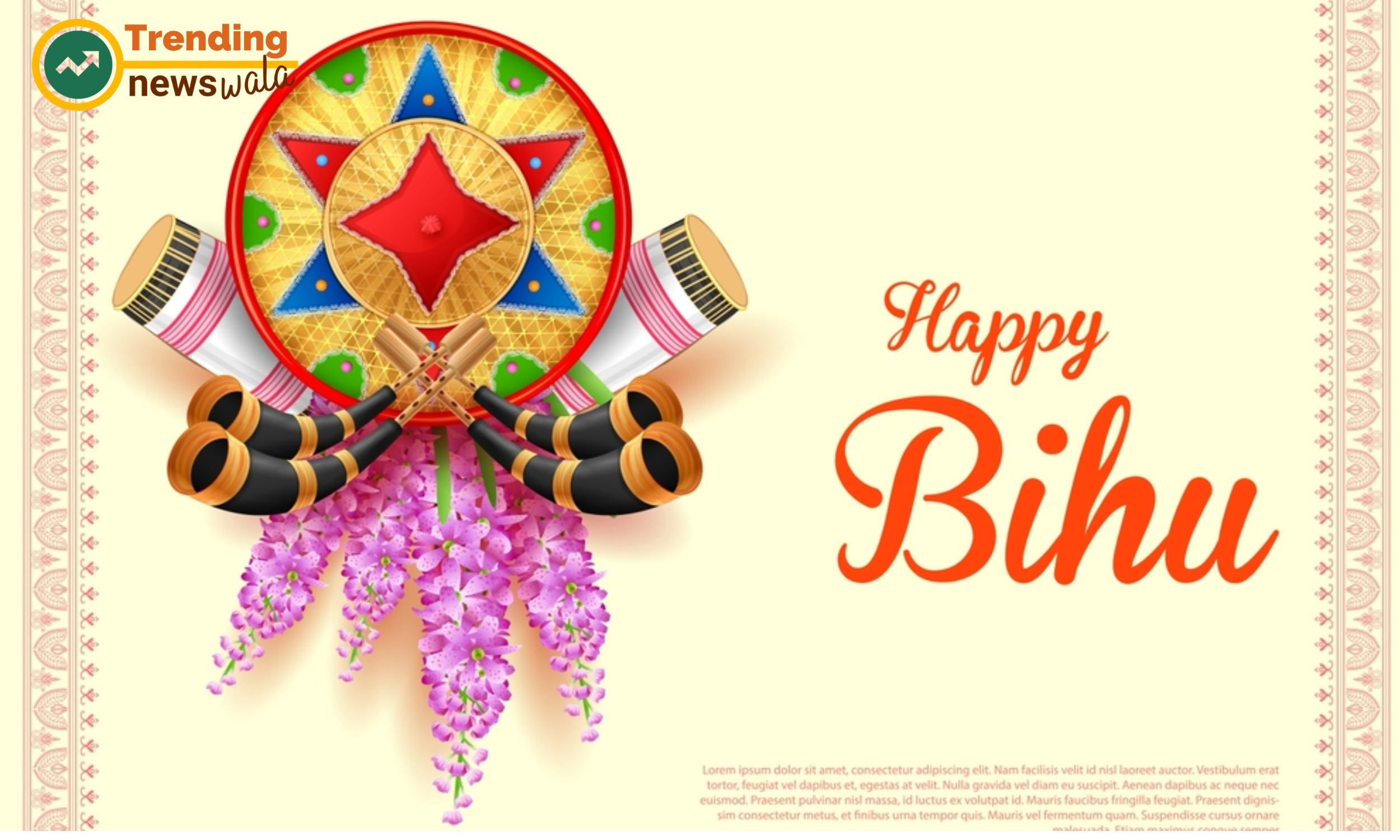
- Bihu festivities are a colorful affair, with people donning traditional Assamese attire such as Mekhela Chador for women and dhoti-kurta or gamosa for men. The vibrant colors and intricate designs add to the festive atmosphere.
- Bihu, the vibrant festival of Assam, is not just about music, dance, and feasting but also about showcasing the rich cultural heritage of the region through traditional attire. The Bihu attire reflects the essence of Assamese identity, with its colorful fabrics, intricate designs, and timeless elegance. From the vibrant Mekhela Chadors of women to the classic dhoti-kurta ensemble of men, Bihu traditional attire holds a special place in the hearts of the Assamese people. Let's delve into the top 10 Bihu traditional attire and explore their significance in Assamese culture.
- Mekhela Chador for Women: The Mekhela Chador is the traditional attire worn by women during Bihu festivals and other cultural occasions. It consists of two main pieces—a cylindrical skirt called the 'mekhela' and a draped cloth worn over the upper body known as the 'chador'. The Mekhela Chador is usually made of silk or cotton and is adorned with intricate motifs and designs, reflecting the artistic craftsmanship of Assamese weavers.
- Dhoti-Kurta for Men: For men, the quintessential Bihu attire is the dhoti-kurta ensemble, which exudes simplicity, elegance, and sophistication. The dhoti is a rectangular piece of cloth wrapped around the waist, while the kurta is a long shirt worn over it. The dhoti-kurta ensemble is typically made of cotton or silk and is often embellished with traditional embroidery or hand-woven patterns, adding a touch of cultural flair to the attire.
- Gamocha: No Bihu attire is complete without the Gamocha, a traditional Assamese scarf that holds immense cultural significance. The Gamocha is worn as a headgear, draped over the shoulders, or tied around the waist, depending on the occasion. It is adorned with intricate designs and motifs, symbolizing hospitality, respect, and cultural pride. The Gamocha is not just a piece of clothing but also a symbol of Assamese identity and unity.
- Riha-Mekhela for Young Girls: Young girls often wear the Riha-Mekhela, a simplified version of the Mekhela Chador, during Bihu festivals. The Riha is a shorter version of the chador, worn over a blouse, while the mekhela serves as the skirt. The Riha-Mekhela is usually made of colorful fabrics such as cotton or silk and is adorned with playful prints and patterns, reflecting the innocence and vibrancy of youth.
- Assamese Silk Saree: The Assamese silk saree is a timeless classic that epitomizes elegance and grace. Worn by women of all ages during Bihu festivals and other ceremonial occasions, the silk saree is characterized by its rich texture, intricate weaving, and vibrant colors. The saree is often embellished with traditional motifs such as the 'jaapi' (Assamese conical hat), 'xorai' (brass offering tray), and 'pitha' (traditional rice cake), adding a touch of cultural symbolism to the attire.
- Gamosa as an Accessory: The Gamosa, a traditional Assamese towel, serves as a versatile accessory that complements Bihu attire. It is often draped over the shoulder or carried in hand as a symbol of respect, hospitality, or festive cheer. The Gamosa is adorned with colorful embroidery, intricate patterns, and symbolic motifs, making it a cherished keepsake and a prized possession for the Assamese people.
- Japi: The Japi is a traditional Assamese conical hat made of bamboo and straw, which is worn by both men and women during Bihu festivals and cultural events. The Japi is intricately woven and adorned with colorful threads, beads, and feathers, making it a striking accessory that adds a touch of rustic charm to Bihu attire. It is not just a fashion statement but also a symbol of Assamese craftsmanship and cultural heritage.
- Assamese Jewelry: Assamese jewelry plays an integral role in enhancing the beauty and elegance of Bihu attire. Women adorn themselves with an array of traditional jewelry such as the 'jonbiri' (necklace), 'doogdoogi' (earrings), 'gamkharu' (bangles), and 'lokaparo' (anklets), which are crafted from gold, silver, or brass. These exquisite pieces of jewelry are often passed down through generations and hold sentimental value for the wearer.
- Traditional Footwear: Traditional footwear such as 'jootis', 'mojaris', or 'patihaans' are worn to complete the Bihu attire. These shoes are typically made of leather or fabric and are embellished with intricate embroidery or decorative embellishments. They are not only stylish and comfortable but also reflect the craftsmanship and cultural heritage of Assam.
- Contemporary Fusion Wear: In recent years, there has been a trend towards blending traditional Bihu attire with contemporary fashion trends to create unique fusion wear. Designers are experimenting with innovative cuts, fabrics, and embellishments to reinvent classic Bihu attire for modern tastes. This fusion of tradition and modernity adds a fresh perspective to Bihu fashion and appeals to a younger generation of Assamese people.
- Bihu traditional attire is more than just clothing; it is a reflection of the rich cultural heritage, artistic craftsmanship, and timeless elegance of Assam. From the vibrant Mekhela Chadors of women to the classic dhoti-kurta ensembles of men, each piece of Bihu attire tells a story of tradition, identity, and pride. As Assamese people come together to celebrate Bihu festivals, they adorn themselves in these exquisite garments, honoring their cultural roots and celebrating the beauty of Assamese heritage.
Cultural Performances:
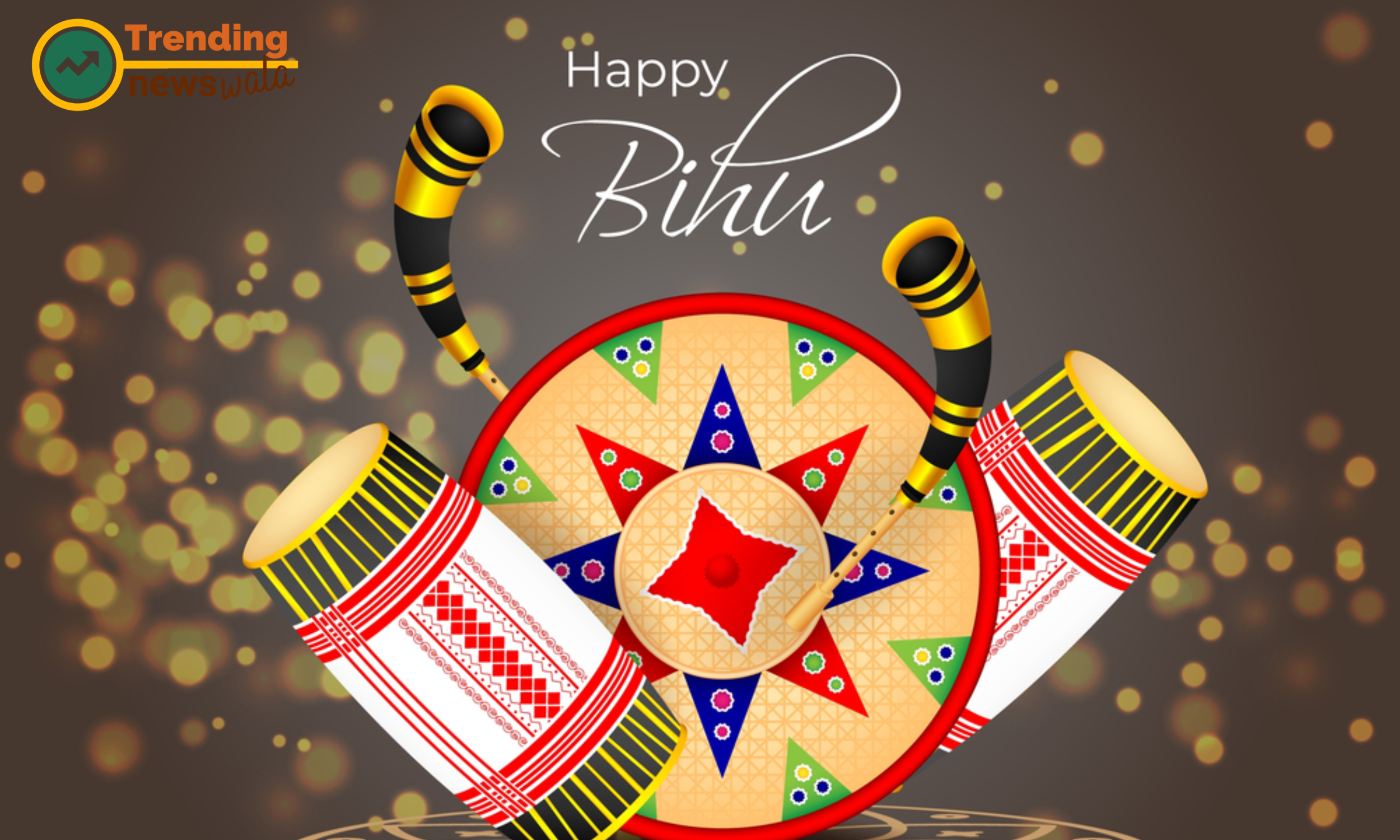
- Cultural performances, including Bihu dance, drama, and music concerts, are an integral part of Bihu celebrations. Artists showcase their talent, keeping alive the rich cultural heritage of Assam and entertaining audiences with their performances.
- Bihu, the vibrant festival of Assam, is not only a time for feasting and merrymaking but also a celebration of the rich cultural heritage of the region. Central to Bihu festivities are the cultural performances that showcase the traditional music, dance, and theater of Assamese culture. From the lively beats of Bihu songs to the graceful movements of traditional dances, these performances embody the spirit and essence of Bihu festivals. Let's explore the top 10 Bihu cultural performances that captivate audiences and enrich the cultural tapestry of Assam.
- Bihu Dance: The Bihu dance is the quintessential cultural performance of Assam, characterized by its energetic movements, rhythmic footwork, and vibrant costumes. It is performed by both men and women during Bihu festivals and other cultural occasions. The dance celebrates the spirit of spring and the joy of harvest, with performers swaying to the infectious beats of traditional Bihu music. The Bihu dance is not only a visual spectacle but also a communal expression of joy, unity, and cultural pride.
- Husori: Husori is a traditional Assamese folk performance that combines music, dance, and theater to narrate stories from Assamese mythology and folklore. It is performed by a group of male performers known as 'husoris' who dress in colorful attire and play traditional musical instruments such as the dhol, pepa, and taal. The husoris move from house to house, spreading festive cheer and blessings during Bihu festivals. The performance evokes a sense of nostalgia and reverence for Assamese traditions.
- Borgeet: Borgeet is a form of devotional music that originated in the Vaishnavite monasteries of Assam. It is characterized by its soulful melodies, poetic lyrics, and spiritual themes. Borgeet songs are sung in praise of Lord Krishna and are an integral part of Bihu cultural performances. The soothing rhythms and melodious tunes of Borgeet evoke a sense of peace and transcendence, transporting listeners to a realm of divine grace and serenity.
- Sattriya Dance: Sattriya is a classical dance form of Assam that originated in the Vaishnavite monasteries or 'sattras' of the region. It is characterized by its graceful movements, intricate footwork, and expressive gestures. Sattriya dance is often performed during Bihu festivals to depict stories from Hindu mythology and the life of Lord Krishna. The dance conveys themes of devotion, love, and spiritual enlightenment, captivating audiences with its beauty and elegance.
- Jeng Bihu: Jeng Bihu is a traditional folk dance of Assam that is performed by young men and women during Bihu festivals. It is characterized by its dynamic movements, rhythmic beats, and colorful costumes. Jeng Bihu dances often depict themes of love, nature, and rural life, with performers enacting scenes from Assamese folklore and mythology. The lively performances create an atmosphere of joy and celebration, inviting audience participation and applause.
- Oja Pali: Oja Pali is a traditional form of folk theater that originated in Assam and is performed during Bihu festivals and other cultural events. It combines music, dance, and storytelling to entertain and educate audiences about moral and social issues. Oja Pali performances feature colorful costumes, lively music, and humorous dialogues, making them a popular form of entertainment during Bihu festivities.
- Bihu Geet: Bihu Geet or Bihu songs are an integral part of Bihu cultural performances, featuring lyrical compositions that celebrate the spirit of Bihu festivals. These songs are sung in traditional Assamese dialects and are accompanied by musical instruments such as the dhol, pepa, and taal. Bihu Geet often convey themes of love, nature, and rural life, resonating with the emotions and experiences of the Assamese people.
- Nasoni Git: Nasoni Git is a traditional form of Assamese folk music that is performed by women during Bihu festivals and other auspicious occasions. It is characterized by its melodious tunes, poetic lyrics, and graceful movements. Nasoni Git songs often depict themes of love, longing, and nostalgia, expressing the sentiments of women in Assamese society. The performances evoke a sense of beauty, grace, and emotional depth, captivating audiences with their soulful melodies.
- Bihu Theater: Bihu theater is a popular form of cultural entertainment in Assam, featuring plays, skits, and dramatic performances that showcase the creativity and talent of Assamese playwrights and actors. These theater productions often explore themes of social issues, historical events, and contemporary challenges facing Assamese society. Bihu theater performances are known for their vibrant storytelling, colorful characters, and thought-provoking narratives, engaging audiences with their wit, humor, and social commentary.
- Traditional Music Ensembles: Traditional music ensembles play a vital role in Bihu cultural performances, providing the rhythmic backdrop and melodic accompaniment to dance, theater, and song. These ensembles typically include instruments such as the dhol (drum), pepa (hornpipe), taal (cymbals), toka (clapper), and flute. The vibrant rhythms and soulful melodies of traditional Assamese music add depth and richness to Bihu cultural performances, enhancing the overall experience for performers and audiences alike.
- Bihu cultural performances are a celebration of Assamese heritage, creativity, and artistic expression. From the lively beats of Bihu dance to the soulful melodies of Borgeet and Nasoni Git, each performance reflects the diversity and vibrancy of Assamese culture. As performers take to the stage to showcase their talents and entertain audiences, they embody the spirit of Bihu festivals and uphold the rich cultural legacy of Assam for generations to come.
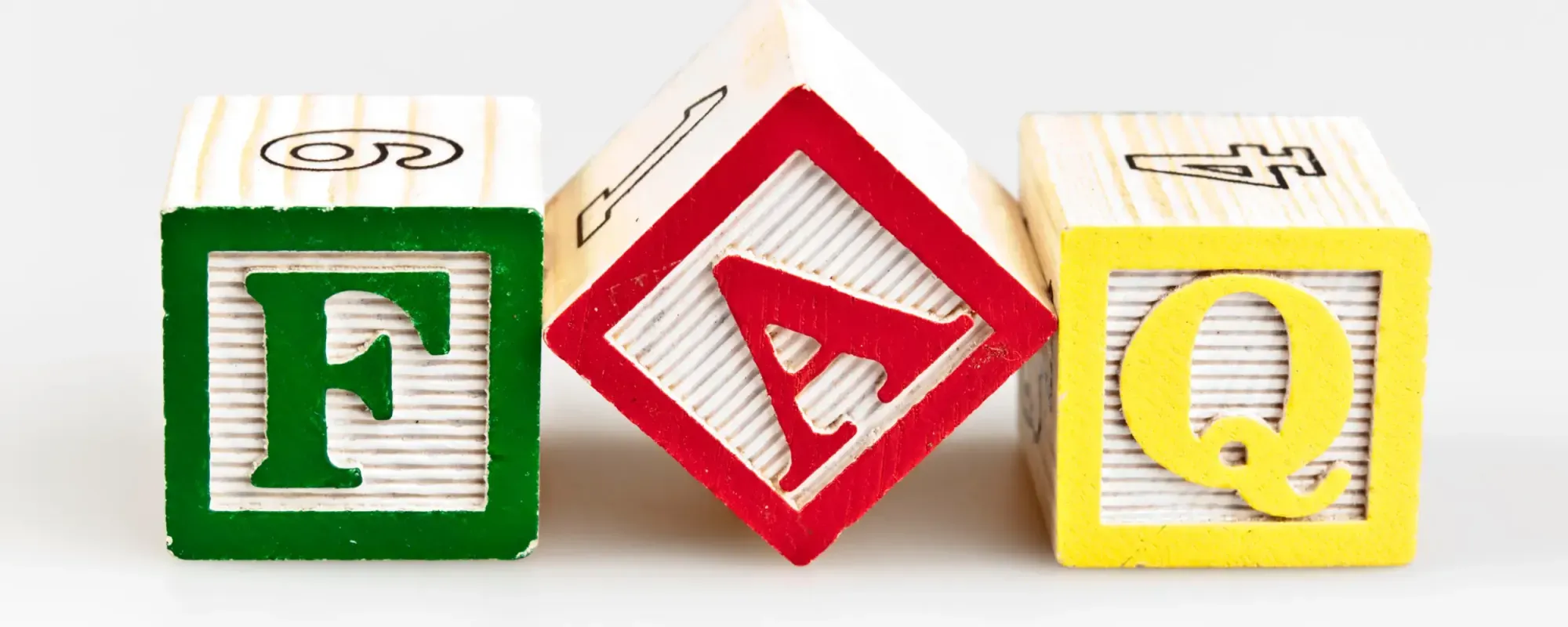
What is Bihu?
Bihu is a set of three cultural festivals celebrated in the Indian state of Assam, marking significant agricultural events. These festivals are Rongali Bihu (Bohag Bihu), Kongali Bihu (Kati Bihu), and Bhogali Bihu (Magh Bihu).
When are the Bihu festivals celebrated?
Rongali Bihu: Celebrated in mid-April, marking the Assamese New Year and the onset of the agricultural season. Kongali Bihu: Celebrated in mid-October, signifying the sowing season and worship of crops. Bhogali Bihu: Celebrated in mid-January, marking the end of the harvest season with feasting and community celebrations.
What are the main features of Bihu celebrations?
Bihu celebrations are characterized by cultural performances like Bihu dance, music, feasting, and traditional rituals such as lighting Mejis (bonfires) during Bhogali Bihu.
What is the significance of Bihu festivals?
Bihu festivals hold agricultural significance, marking various stages of the farming calendar. They also signify community bonding, cultural pride, and gratitude towards nature.
What are the traditional Bihu dances?
Bihu Dance: A lively folk dance performed during Rongali Bihu, characterized by energetic movements and vibrant attire. Husori: A traditional male group dance performed during Bihu festivals, involving music, dance, and blessings. Jeng Bihu: A folk dance performed by young men and women, depicting themes of love and nature.
What traditional attire is worn during Bihu festivals?
Traditional attire includes Mekhela Chador for women, Dhoti-Kurta for men, Assamese silk sarees, and accessories like Gamocha (scarf) and Japi (hat).
What are the traditional Bihu songs called?
Bihu Geet or Bihu songs are an integral part of the celebrations, sung in Assamese dialects and accompanied by traditional instruments like dhol, pepa, and taal.
What traditional dishes are prepared during Bhogali Bihu?
Bhogali Bihu is known for its lavish feasts featuring traditional Assamese dishes like pitha (rice cakes), laru (sweet balls), masor tenga (sour fish curry), and various other delicacies.
How do people celebrate Bhogali Bihu?
Bhogali Bihu is celebrated with community bonfires called Mejis, feasting, cultural performances, and traditional games like buffalo fights and egg fights.
What is the significance of Bihu in Assamese culture?
Bihu festivals are deeply ingrained in Assamese culture, symbolizing the agricultural cycle, communal harmony, and cultural heritage of the region. They are a time for celebration, reflection, and unity among the people of Assam.

